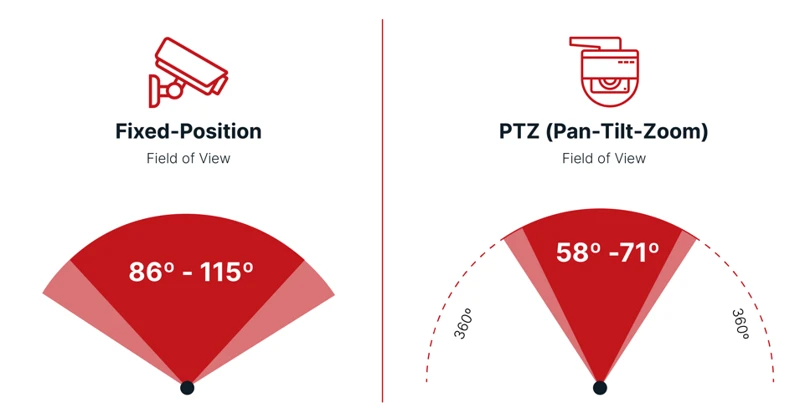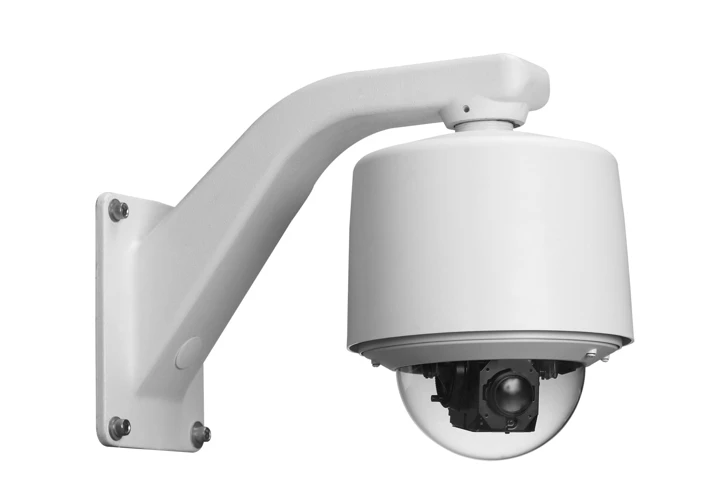If you’re in the market for a security system, you might find yourself debating between PTZ cameras and fixed cameras. Both options have their advantages and disadvantages, but which one is better for your specific needs? It’s understandable to feel perplexed when facing this decision, but fear not, as we’re here to clarify any confusion. In this article, we’ll break down the differences between PTZ cameras and fixed cameras, comparing their field of view, zoom capabilities, costs, installation and configuration, and more. By the end of this article, you’ll have a better understanding of which type of camera will be the best fit for your security system.
What are PTZ Cameras?

When it comes to designing a security system, choosing the right type of camera is crucial to achieving your desired level of security. PTZ cameras are a popular type of security camera that can offer unique features and benefits for specific situations. If you’re unfamiliar with PTZ cameras and what they have to offer, you’ve come to the right place. In this section, we’ll explore what makes PTZ cameras different from other types of cameras and what advantages and disadvantages they bring to the table. For more information on other factors to consider when choosing a surveillance camera, check out our guide to video surveillance camera factors.
Advantages of PTZ Cameras
PTZ cameras, also known as pan-tilt-zoom cameras, are advanced surveillance devices that offer numerous benefits. These cameras allow users to move the camera’s direction, zoom in and out, and adjust the focus. Here are some of the advantages of using PTZ cameras:
| Advantages of PTZ Cameras |
|---|
| Wide Coverage: PTZ cameras offer an extensive range of coverage. With the ability to move and zoom the camera, you can cover a wider area with fewer cameras. This makes it more cost-effective for larger areas, such as parking lots or perimeters. |
| Flexible Monitoring: PTZ cameras provide more flexibility in monitoring. You can move the camera as needed to get a clear view of a specific area. This makes them ideal for use in areas where the requirements change, such as stadiums or event venues, where the focus areas change frequently. |
| Zoom Capability: PTZ cameras offer superior zoom capabilities. They allow users to zoom in and out on a subject, providing a closer look at suspicious activity or individuals. This makes them ideal for identifying faces, license plates, or other critical details. |
| Advanced Features: PTZ cameras come with advanced features like auto-tracking, which follows moving objects, and presets that enable the camera to move to specific positions. These features make it easier to monitor a large area with fewer cameras. |
| Remote Access: Many PTZ cameras come with remote access features that allow users to access the cameras from their smartphones, laptops, or desktops. This makes it easier to monitor the area even when you are not physically present. |
| Increased Deterrence: The ability to move and zoom the camera makes PTZ cameras more visible to potential intruders, increasing the likelihood of deterrence. This is particularly useful in areas where high security is required, such as governmental or military facilities. |
PTZ cameras are an excellent option for those looking for flexible and powerful surveillance solutions. However, they do have some downsides to consider, which we will explore in the next section.
Disadvantages of PTZ Cameras
PTZ cameras come with a few disadvantages that make them not suitable for all security systems. One of the main disadvantages of PTZ cameras is the higher cost compared to fixed cameras. Due to the advanced features such as the ability to pan, tilt, and zoom, PTZ cameras tend to be pricier than fixed cameras. This higher cost can make them prohibitive for some budgets.
Another disadvantage of PTZ cameras is their complexity. These cameras have many moving parts, and they require skilled professionals to install and configure them properly. This process can be time-consuming, and in most cases, professional help is necessary. Additionally, PTZ cameras require regular maintenance to keep them in good working condition, which can add to the overall cost of the security system.
Aside from the cost and complexity, PTZ cameras cover a narrow field of view, particularly when compared to fixed cameras. They also tend to have a shorter lifespan than fixed cameras since they consist of moving parts that can wear out over time. Another thing to note is that PTZ cameras can be more challenging to hide, which can be a disadvantage if you’re looking for a discreet camera.
Finally, PTZ cameras can be challenging to integrate with other sensors and systems, which limits their functionality. This is particularly true for PTZ cameras that use proprietary protocols as it can be harder to find compatible surveillance software. With these limitations in mind, it’s essential to consider the specific needs of your security system before choosing between PTZ and fixed cameras.
While PTZ cameras have many advantages, they come with a few drawbacks. Their higher cost, complexity, narrow field of view, and shorter lifespan make them less suitable for some security systems. However, the decision on whether to use PTZ cameras or fixed cameras ultimately depends on your security needs and whether the advantages outweigh the disadvantages.
What are Fixed Cameras?

When it comes to security systems, fixed cameras are a popular choice for indoor and outdoor surveillance. Fixed cameras, as the name suggests, are stationary cameras that record a constant view. These cameras are a great addition to any security system because they provide constant monitoring of a specific area. However, it’s important to note that not all fixed cameras are created equal. There are several factors to consider when choosing the best fixed camera for your security system. To learn more about these factors, check out our article on surveillance camera lenses.
Advantages of Fixed Cameras
Fixed cameras are one of the primary types of surveillance cameras used in various security systems. They offer several advantages over other types of cameras, including:
- Consistent Field of View: Fixed cameras provide a consistent and stable field of view, which means they can capture clear and continuous footage of a specific area without any significant shifts in angles or perspectives.
- Cost-Effective: Fixed cameras are often more affordable than other types of cameras, such as PTZ cameras, making them an ideal choice for those on a budget.
- Durable: Most fixed cameras are designed to withstand harsh weather conditions, which makes them suitable for outdoor use. Additionally, they require less maintenance than PTZ cameras, which can reduce long-term costs.
- High-Quality Images: Fixed cameras can capture high-quality images and videos with low distortion, making them ideal for identifying people, vehicles, or objects in the footage.
- Simple Installation: Fixed cameras are relatively easy to install, and they require fewer accessories and components compared to PTZ cameras.
However, it’s important to note that fixed cameras have some downsides as well, such as limited field of views and lack of zoom capabilities. To choose the best surveillance camera for your needs, it’s essential to consider both the advantages and disadvantages of each type of camera. You may also want to read more about /indoor-outdoor-surveillance-cameras/ or /wired-vs-wireless-security-cameras/ to decide which type of camera is right for you.
Disadvantages of Fixed Cameras
Fixed cameras have their own set of disadvantages that need to be considered before making a decision for your security system. Let’s take a look at some of them below:
| Disadvantages of Fixed Cameras |
|---|
| Limited field of view |
| Cannot change angle or position remotely |
| Limited zoom capabilities |
| No tracking or following abilities |
| May require additional cameras to cover a larger area |
| May not perform well in low light conditions |
| May not capture enough detail due to lower megapixel count |
| May be more visible and therefore susceptible to tampering or vandalism |
| May require professional installation and additional equipment such as camera mounts |
As can be seen from the table above, fixed cameras have a limited field of view and cannot change angle or position remotely, so multiple cameras may be needed to cover a larger area. They also have limited zoom capabilities and lack tracking or following abilities.
Fixed cameras may not perform well in low light conditions, which can affect the clarity of the captured footage. They may also have lower megapixel count, which can lead to a lack of captured detail.
Another disadvantage of fixed cameras is that they may be more visible and therefore more susceptible to tampering or vandalism, which can compromise the security of the system. Additionally, they may require professional installation and additional equipment such as camera mounts.
It is important to take these disadvantages into consideration when deciding whether a fixed camera is suitable for your security needs. For more information on other important aspects of surveillance cameras, you can check out our other articles on megapixels and image resolution, low-light cameras, hidden and visible cameras, and analytics benefits. Also, don’t forget about the importance of camera mounts, which we discussed in our article on essential camera mounts for surveillance.
Comparison of PTZ and Fixed Cameras

When it comes to choosing the right security camera system, one of the biggest decisions you’ll have to make is whether to go with PTZ or Fixed cameras. Both types have their own unique benefits and drawbacks, so it’s important to carefully consider which option will best suit your needs. In the following section, we’ll compare the two types of cameras, highlighting the key differences in terms of Field of View, Zoom Capabilities, Costs, and Installation and Configuration. By the end of this section, we hope to provide you with a clearer understanding of the pros and cons of each camera type, helping you to make an informed decision for your security system.
Field of View
When it comes to field of view, there are significant differences between PTZ and fixed cameras.
PTZ Cameras:
- Offer a 360-degree view of the area to be monitored.
- Can pan, tilt, and zoom to focus on specific areas of interest.
- Automatically track moving objects, making them ideal for use in large open spaces.
Fixed Cameras:
- Have a limited field of view that is fixed in position.
- Do not offer the ability to pan, tilt or zoom so the entire area may not be covered.
- Need to be placed strategically to ensure full area coverage.
The PTZ cameras offer far more flexibility in terms of monitoring and can be used to cover vast areas with unmatched precision. Fixed cameras, while cheaper, are not as versatile and may require multiple cameras to cover the same area a single PTZ camera can cover. However, with fixed cameras, you can have focused areas that can be monitored more closely but require more cameras. So it’s crucial to determine the areas that require detailed monitoring beforehand.
Each camera type has its own advantages, and it depends on the user’s specific needs in terms of field of view. However, it’s important to note that PTZ cameras may require fewer cameras to cover a large area and offer exceptional monitoring capabilities.
Zoom Capabilities
When it comes to zoom capabilities, PTZ cameras definitely have the upper hand over fixed cameras. PTZ cameras can easily zoom in and out, providing a more detailed view of the area being monitored. This feature is especially useful in security systems, where you may need to closely monitor a specific location or individual.
PTZ Camera Zoom Capabilities
One of the main advantages of PTZ cameras is their ability to zoom in and out. Some PTZ cameras can zoom up to 30x, providing crystal-clear images from far away. This is particularly useful in outdoor security systems where the camera may need to cover a large area, such as a parking lot or outdoor patio. PTZ cameras can also pan and tilt to capture different angles, making them more versatile.
Fixed Camera Zoom Capabilities
Fixed cameras, on the other hand, have limited zoom capabilities. Their field of view is fixed, and they can’t zoom in or out. If you need to view something in more detail, you would have to physically move the camera or install additional cameras in the area. This can be costly and time-consuming, especially if you have a large property to monitor.
To summarize, if zoom capabilities are a priority for your security system, PTZ cameras are the way to go. With their ability to zoom in and out, pan and tilt, and capture different angles, PTZ cameras provide a more detailed view of the area being monitored. While fixed cameras have their advantages, they simply can’t match the zoom capabilities of PTZ cameras.
Costs
When deciding on a security system, cost is one of the most important factors to consider. PTZ cameras and fixed cameras have differing costs.
PTZ Cameras Costs
PTZ cameras tend to be more expensive than fixed cameras, costing around $500 to $1000 per camera. This price often includes the cost of the camera plus installation and configuration. Additionally, PTZ cameras require more maintenance than fixed cameras, which can add to their overall cost over time.
Fixed Cameras Costs
Fixed cameras are generally less expensive than PTZ cameras, costing between $100 to $500 per camera. This price also includes the cost of the camera plus installation and configuration. Fixed cameras have simpler mechanisms, which makes them easier and cheaper to maintain.
When deciding on a security system, it is important to determine which type of camera fits your budget. While PTZ cameras may offer more advanced features, fixed cameras often provide more affordable and cost-effective solutions. Additionally, it is important to keep in mind not only the cost of the cameras themselves, but also the cost of installation, maintenance, and repairs over time.
| PTZ Cameras | Fixed Cameras | |
|---|---|---|
| Cost Per Camera | $500 to $1000 | $100 to $500 |
| Maintenance Costs | Higher maintenance costs | Lower maintenance costs |
Installation and Configuration
When it comes to installation and configuration, both PTZ and fixed cameras have their pros and cons.
Fixed cameras are typically easier to install and configure compared to PTZ cameras. This is because they do not require complicated movements and positioning setups. With fixed cameras, you simply mount them in the desired location and adjust them slightly to get the desired field of view. This means that installation is usually faster, which can save you time, labor, and ultimately, money.
On the other hand, PTZ cameras are a bit more complicated to install and configure. They require careful placement and calibration to ensure they are covering the desired area and moving smoothly between preset positions. PTZ cameras also require additional hardware like a joystick or controller for precise movements. This can add to the cost and complexity of installation and configuration.
To better understand the differences between PTZ and fixed cameras, let’s compare their installation and configuration specifications in this table:
| Camera Type | Ease of Installation | Configuration Complexity |
|---|---|---|
| PTZ Cameras | More difficult | More complicated |
| Fixed Cameras | Easier | Less complicated |
As you can see, there are pros and cons to both types of cameras when it comes to installation and configuration. Fixed cameras are easier to install and require less setup, while PTZ cameras may require more time and additional equipment for proper installation and configuration. It’s important to consider the specific needs of your security system and budget when deciding which type of camera is best for you.
Which One is Better for Your Security System?
When deciding between PTZ cameras and fixed cameras for your security system, it is important to consider your individual needs and preferences.
If you need to cover a large area with a single camera, then a PTZ camera may be the better option. These cameras can pan, tilt, and zoom to capture a wide range of views and can be controlled remotely to follow any movement or activity. However, if your main objective is to monitor a specific area or entrance, a fixed camera may be more suitable for your needs.
Additionally, if you have a limited budget, fixed cameras are generally less expensive than PTZ cameras. They also often have a more straightforward setup, which can save time and labor costs.
On the other hand, if you require a more detailed view of an area, such as the faces of individuals or the license plates of vehicles, a PTZ camera may be the better choice. These cameras have the ability to zoom in and out, allowing for greater detail.
It is important to consider the maintenance and upkeep of your security system. PTZ cameras have moving parts that may require more maintenance and repair than fixed cameras.
Ultimately, the decision between PTZ and fixed cameras comes down to your specific security needs and priorities. Consider the size of the area you need to monitor, the level of detail required, the budget, and the resources available for maintenance and repair before making a choice.
Both PTZ cameras and fixed cameras have their advantages and disadvantages, and the best choice for your security system will depend on your unique circumstances. Weighing the pros and cons of each option can help you make an informed decision and ensure that your security system meets your specific requirements.
Conclusion
After discussing the advantages and disadvantages of PTZ and Fixed Cameras, it’s clear that both types have their own unique features and functions that make them useful in certain security situations.
Ultimately, the choice between PTZ and Fixed Cameras depends on your specific security needs and budget. If you require an extensive range of coverage and flexibility, PTZ Cameras could be a great fit for your system. However, if your focus is on capturing high-quality video in a fixed area continuously, then Fixed Cameras may be a better choice.
It’s important to consider the field of view, zoom capabilities, costs, and installation and configuration when comparing these two types of cameras. PTZ Cameras offer a wider range of movement and can zoom in on specific areas, while Fixed Cameras have a more limited field of view but provide a continuous, high-quality video stream.
One thing to keep in mind is that PTZ Cameras tend to be more expensive than Fixed Cameras, and they also require more resources to install and configure. So, if you’re working with a tight budget or limited resources, Fixed Cameras might be the better option.
Ultimately, the right camera for your security system will depend on your specific needs and situation. Regardless of which type you choose, it’s important to prioritize security and safety to protect your property and people. Whether you opt for PTZ or Fixed Cameras, make sure to select a reputable manufacturer and installer and invest in regular maintenance and updates to maximize the effectiveness and longevity of your security system.
Frequently Asked Questions
1. Can PTZ cameras cover a larger area than fixed cameras?
Yes, PTZ cameras have the ability to pan, tilt and zoom, which allows them to cover a larger area than fixed cameras.
2. Are PTZ cameras more expensive than fixed cameras?
Yes, generally PTZ cameras are more expensive than fixed cameras due to their advanced features.
3. Do PTZ cameras require more maintenance than fixed cameras?
Yes, PTZ cameras have moving parts that require regular maintenance to ensure proper operation.
4. Are fixed cameras able to zoom in on specific areas like PTZ cameras?
No, fixed cameras do not have the ability to zoom in on specific areas like PTZ cameras.
5. Are fixed cameras easier to install than PTZ cameras?
Yes, fixed cameras are generally easier to install than PTZ cameras due to their simpler setup.
6. Can PTZ cameras be controlled remotely?
Yes, most PTZ cameras can be controlled remotely through software or apps.
7. Are fixed cameras able to provide clearer images than PTZ cameras?
No, the image quality of both fixed and PTZ cameras depends on the camera’s specifications and resolution.
8. Do PTZ cameras use more energy than fixed cameras?
Yes, due to their advanced features, PTZ cameras require more energy than fixed cameras.
9. Can fixed cameras be used in outdoor environments?
Yes, there are many fixed cameras specifically designed for outdoor use.
10. Are PTZ cameras suitable for small spaces?
Not necessarily, PTZ cameras are designed for larger areas and may not be suitable for small spaces.







